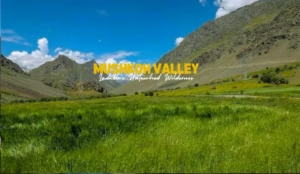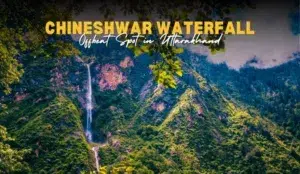“Explore Nag Tibba: Trek to serenity 🏔️ Discover stunning landscapes, local culture, and breathtaking sunrises. A Himalayan adventure awaits!”
About Nag Tibba:
Nag Tibba, known as the “Serpent’s Peak,” is a captivating trekking destination nestled in the picturesque foothills of the Indian Himalayas. This enchanting location offers a harmonious blend of natural wonders, cultural encounters, and thrilling adventures, making it a cherished choice among trekkers of diverse expertise. Meandering through dense woodlands, rustic hamlets, and expansive meadows, the trekking trails of Nag Tibba promise an unforgettable and rejuvenating expedition.
- Nag Tibba is a captivating trekking destination in the Indian Himalayas.
- Known as the “Serpent’s Peak,” it offers a blend of natural wonders, cultural encounters, and adventure.
- Trekkers of all levels are drawn to its trails winding through dense forests, rustic villages, and vast meadows.
- The trek promises an unforgettable and rejuvenating expedition.
History of Nag Tibba:
The historical tapestry of Nag Tibba is intricately woven with the vibrant threads of local heritage and legends. The name “Nag Tibba,” translating to “Serpent’s Peak,” carries profound significance rooted in the area’s folklore. The peak’s association with Nag Devta, the serpent deity, is deeply revered, and the trek to the summit holds profound spiritual value within the indigenous populace. Passed down through generations, the stories surrounding this hallowed peak infuse cultural richness into the trekking experience. Evolving from a revered pilgrimage site to an alluring trekking haven, Nag Tibba attracts adventurers and nature enthusiasts worldwide to bask in its awe-inspiring allure.
- Nag Tibba, meaning “Serpent’s Peak,” is entwined with local heritage and legends.
- It holds spiritual significance as the abode of Nag Devta, the serpent deity.
- The summit trek has profound spiritual value in the indigenous community.
- Stories of Nag Tibba have been passed down through generations, enriching its cultural tapestry.
- The peak has transformed from a revered pilgrimage site to an enticing trekking haven.
Nag Tibba Travel Guide
Nag Tibba, often referred to as the “Serpent’s Peak,” is a captivating trekking destination nestled in the picturesque foothills of the Indian Himalayas. This enchanting location offers a harmonious blend of natural wonders, cultural encounters, and thrilling adventures, making it a cherished choice among trekkers of diverse expertise. Meandering through dense woodlands, rustic hamlets, and expansive meadows, the trekking trails of Nag Tibba promise an unforgettable and rejuvenating expedition.
Key Highlights:
- Trekking Routes: Explore various trekking routes leading to the summit of Nag Tibba.
- Flora and Fauna: Encounter diverse plant and animal species along the trails.
- Local Culture: Engage with local communities and learn about their traditions.
- Camping Experience: Enjoy the thrill of camping amidst the serene mountains.
- Sunrise Views: Witness breathtaking sunrises from the Nag Tibba summit.
- Photography Opportunities: Capture the natural beauty and stunning vistas.
- Best Time to Visit: Plan your trip during the ideal months for trekking.
- Essential Packing: Pack the necessary gear and essentials for a comfortable trek.
- Safety Tips: Follow safety guidelines and responsible trekking practices.
- Nearby Attractions: Explore nearby places like Mussoorie and Dehradun.
- Culinary Delights: Discover local cuisine and dining options.
Why Nag Tibba is Famous:
Nag Tibba has gained fame for its unparalleled natural beauty, cultural richness, and abundant adventure opportunities. As the “Serpent’s Peak,” it presents a captivating blend of elements that attract trekkers and nature enthusiasts alike. The allure lies in its diverse landscapes, including dense forests, rustic villages, and expansive meadows, offering an unforgettable journey. The spiritual significance as the abode of Nag Devta and the chance to witness stunning sunrises from its summit contribute to its unique reputation, making Nag Tibba a cherished destination.
- Natural Beauty: Renowned for its stunning landscapes and breathtaking vistas.
- Cultural Significance: The “Serpent’s Peak” holds spiritual value as the abode of Nag Devta.
- Adventure Hub: Offers thrilling treks through dense forests, charming villages, and lush meadows.
- Unique Experience: Blends natural allure, cultural heritage, and spiritual connection.
- Sunrise Spectacle: Trekkers can witness mesmerizing sunrises from the summit.
- Mystique and Charm: The blend of mystique, adventure, and spirituality adds to its fame.
- Tranquil Environment: Provides an escape from the hustle and bustle of city life.
- Photography Paradise: Offers endless opportunities for capturing stunning shots.
- Accessible Trek: Suitable for both novice and experienced trekkers.
- Memorable Journeys: Leaves an everlasting impression on all who explore its trails.
Things to Do in Nag Tibba:
- Trekking Exploration: Embark on a thrilling trek through varied terrains and immerse yourself in the Himalayan wilderness.
- Camping Amidst Nature: Set up camps in picturesque locations, surrounded by the tranquility of the mountains.
- Cultural Immersion: Engage with local communities, learn about their traditions, and savor authentic regional cuisine.
- Scenic Panoramas: Capture awe-inspiring views of snow-clad peaks and lush valleys from the summit.
- Spiritual Connection: Delve into the spirituality tied to Nag Tibba’s history as a revered site of Nag Devta.
- Wildlife Spotting: Observe the diverse flora and fauna, including langurs, foxes, and various bird species.
- Photography Paradise: Capture the beauty of the landscapes, wildlife, and unique flora on camera.
- Mesmerizing Sunrises: Experience the magical moment of sunrise, casting vibrant colors across the sky.
- Adventurous Thrills: Challenge yourself with the trek, navigate the trails, and conquer the peak.
- Personal Triumph: Achieve a sense of accomplishment as you reach the summit and complete the trek.
- Lasting Memories: Forge memories around campfires, under starry skies, and amid the majesty of the mountains.
The thing to know about Nag Tibba
Nag Tibba, often referred to as the “Serpent’s Peak,” is a popular trekking destination located in the Indian state of Uttarakhand. This picturesque mountain offers a captivating trekking experience, making it an ideal choice for both beginners and seasoned trekkers. Nestled at an altitude of about 3,022 meters (9,915 feet) above sea level, Nag Tibba provides breathtaking panoramic views of the snow-capped Himalayan ranges, including Bandarpoonch, Swargarohini, Srikantha, and Black Peak.
Key points about Nag Tibba:
- Trek Difficulty: Nag Tibba is known for its moderate trek difficulty, making it suitable for trekkers of various fitness levels. The trek usually takes around 2-3 days to complete.
- Starting Point: The base camp for the Nag Tibba trek is often reached from a small village called Pantwari, which can be accessed from Dehradun, a major city in Uttarakhand.
- Scenic Beauty: The trek offers a diverse range of landscapes, from dense forests and meadows to rocky terrains. The route is adorned with a variety of flora and fauna, adding to its natural charm.
- Camping Experience: There are several camping sites along the trail, allowing trekkers to immerse themselves in the serene Himalayan environment. One of the most famous camping sites is the Nag Tibba Temple, after which the peak is named.
- Local Culture: Trekkers also have the opportunity to interact with the local communities residing in the region. This offers a glimpse into the traditional mountain lifestyle and culture.
- Weather: It’s important to note that the weather can be unpredictable, so trekkers should be prepared for sudden changes in temperature and conditions, especially during the winter months.
- Accessibility: Nag Tibba is relatively accessible and can be undertaken as a weekend getaway from nearby cities like Dehradun and Mussoorie.
- Sunrise and Sunset Views: The summit of Nag Tibba provides stunning sunrise and sunset views over the Himalayas, creating unforgettable memories for trekkers.
- Permits and Regulations: While the trek doesn’t require special permits, it’s advised to check the local regulations and weather conditions before embarking on the journey.
How to Reach Nag Tibba:
Reaching Nag Tibba involves a journey that combines various modes of transportation and a spirit of adventure. The starting point for most trekkers is Dehradun, a well-connected city in Uttarakhand. From Dehradun, you can travel to the base village of Pantwari, which serves as the gateway to Nag Tibba. The journey from Dehradun to Pantwari takes approximately 3-4 hours by road. You can hire a local taxi or take a public bus. Once in Pantwari, the trek to Nag Tibba begins, leading you through captivating landscapes, charming villages, and breathtaking meadows.
- Starting Point: Dehradun, a well-connected city in Uttarakhand.
- Base Village: Pantwari, the gateway to the Nag Tibba trek.
- Travel Time: About 3-4 hours by road from Dehradun to Pantwari.
- Transportation Options: Hire a local taxi or take a public bus from Dehradun to Pantwari.
- Trek Starting Point: Pantwari is where the trek to Nag Tibba begins.
- Trek Experience: Journey through enchanting landscapes, dense forests, quaint villages, and vast meadows.
- Adventure Awaits: Reaching Nag Tibba is more than a destination; it’s a journey of discovery and embracing nature’s beauty.
Travel Tips for Nag Tibba:
- Weather Awareness: Check the weather forecast before starting the trek and pack accordingly.
- Fitness Preparation: Engage in regular exercise and basic fitness routines to ensure a comfortable trek.
- Appropriate Clothing: Dress in layers to adapt to changing temperatures during the trek.
- Comfortable Footwear: Wear sturdy, comfortable trekking shoes with good grip.
- Hydration and Nutrition: Carry sufficient water and energy-packed snacks to stay hydrated and energized.
- Permits and Permissions: Obtain any necessary permits or permissions required for the trek.
- Guides and Maps: Consider hiring a local guide for a smoother trekking experience and access to local insights.
- Leave No Trace: Respect the environment by following the principle of “Leave No Trace” and carrying back all waste.
- Safety Gear: Carry basic safety gear such as a first-aid kit, flashlight, and multi-tool.
- Respect Local Culture: Interact respectfully with local communities and be mindful of their customs and traditions.
Best Time To Visit Nag Tibba:
The best time to visit Nag Tibba is during the months of April to June and September to November. These periods offer the most favorable weather conditions for trekking. From April to June, the weather is mild and pleasant, with clear skies and comfortable temperatures. This is an ideal time to witness the vibrant flora and enjoy the lush landscapes.
Similarly, from September to November, the monsoon has passed, and the region is bathed in clear sunlight, making it perfect for trekking. The views of the Himalayan peaks are breathtaking, and the moderate temperatures add to the overall trekking experience. It’s advisable to avoid the winter months as the region receives heavy snowfall, making the trails challenging and inaccessible.
The optimal periods to explore Nag Tibba are April to June and September to November. During these months, the weather is pleasant, making it the perfect time for a trekking adventure.
- April to June: This period offers mild temperatures and clear skies, creating ideal conditions for trekking. The trails are adorned with vibrant flora, enhancing the scenic beauty.
- September to November: After the monsoon season, the weather stabilizes, providing clear views of the surrounding Himalayan peaks. The moderate temperatures and crisp air add to the overall trekking experience.
Places To Eat Near Nag Tibba:
When it comes to dining near Nag Tibba, there are a few options that offer a taste of local flavors and sustenance for trekkers:
- Pantwari Village: The base village for the Nag Tibba trek offers basic eateries where you can enjoy simple meals before beginning your trek.
- Dehradun: As the starting point for many trekkers, Dehradun has a variety of restaurants offering North Indian cuisine and local delicacies.
- Mussoorie: If you’re staying in Mussoorie before or after the trek, you’ll find a range of dining options from local street food to restaurants serving diverse cuisines.
Nearby Places of Nag Tibba:
Nag Tibba’s vicinity offers a range of captivating destinations that are worth exploring, extending your adventure beyond the trek itself. One such nearby place is Mussoorie, a popular hill station known for its stunning views, bustling markets, and charming colonial architecture. The town’s lively atmosphere and various attractions, including Gun Hill and Kempty Falls, make it an ideal post-trek destination. Another nearby gem is Dehradun, the gateway to Nag Tibba, which boasts attractions like Robber’s Cave and the Mindrolling Monastery. These nearby places provide an opportunity to delve into the region’s natural beauty, culture, and history, enhancing your overall experience.
Points of Interest:
- Mussoorie: Explore the vibrant streets, enjoy panoramic views from viewpoints, and immerse yourself in local culture.
- Kempty Falls: Witness the cascading beauty of Kempty Falls and soak in its refreshing waters.
- Gun Hill: Take a cable car ride to Gun Hill for panoramic views of the Himalayas and the Doon Valley.
- Dehradun: Visit the iconic Clock Tower, Paltan Bazaar, and immerse yourself in the city’s lively vibe.
- Robber’s Cave: Discover the unique geological formation of Robber’s Cave and enjoy its serene surroundings.
- Mindrolling Monastery: Experience spiritual tranquility at this renowned Tibetan Buddhist monastery.
Conclusion: A Journey to Remember
In the heart of the Himalayas, Nag Tibba beckons adventurers to embark on a journey of a lifetime. The trek’s natural beauty, cultural richness, and the thrill of exploration make it an experience that transcends words. So pack your bags, lace up your boots, and let Nag Tibba weave its magic on your soul.
FAQs
Is Nag Tibba suitable for beginners?
Absolutely! Nag Tibba is an ideal choice for novice trekkers due to its moderate difficulty level.
What is the best time to witness the sunrise from Nag Tibba?
Sunrise from Nag Tibba is best witnessed in the early morning hours, around 5:30 am.
Are there any age restrictions for the trek?
While there are no strict age restrictions, trekkers should be in reasonably good physical condition.
Do I need to hire a guide for the trek?
While it’s possible to trek independently, hiring a local guide enhances the experience and ensures safety.
Are there any accommodation options along the trail?
Trekkers stay in tents during the journey, and camping is part of the experience, adding to the adventure.





